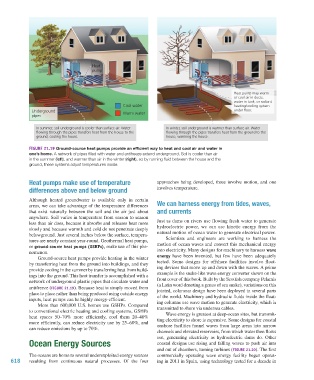Page 619 - Environment: The Science Behind the Stories
P. 619
Heat
pump
Heat pump may warm
or cool air in ducts,
water in tank, or radiant
Cool water heating/cooling system
Underground Warm water under floor.
pipes
In summer, soil underground is cooler than surface air. Water In winter, soil underground is warmer than surface air. Water
flowing through the pipes transfers heat from the house to the flowing through the pipes transfers heat from the ground to the
ground, cooling the house. house, warming the house.
Figure 21.19 Ground-source heat pumps provide an efficient way to heat and cool air and water in
one’s home. A network of pipes filled with water and antifreeze extend underground. Soil is cooler than air
in the summer (left), and warmer than air in the winter (right), so by running fluid between the house and the
ground, these systems adjust temperatures inside.
Heat pumps make use of temperature approaches being developed, three involve motion, and one
differences above and below ground involves temperature.
Although heated groundwater is available only in certain
areas, we can take advantage of the temperature differences We can harness energy from tides, waves,
that exist naturally between the soil and the air just about and currents
anywhere. Soil varies in temperature from season to season
less than air does, because it absorbs and releases heat more Just as dams on rivers use flowing fresh water to generate
slowly and because warmth and cold do not penetrate deeply hydroelectric power, we can use kinetic energy from the
belowground. Just several inches below the surface, tempera- natural motion of ocean water to generate electrical power.
tures are nearly constant year-round. Geothermal heat pumps, Scientists and engineers are working to harness the
or ground-source heat pumps (GsHPs), make use of this phe- motion of ocean waves and convert this mechanical energy
nomenon. into electricity. Many designs for machinery to harness wave
Ground-source heat pumps provide heating in the winter energy have been invented, but few have been adequately
by transferring heat from the ground into buildings, and they tested. Some designs for offshore facilities involve float-
provide cooling in the summer by transferring heat from build- ing devices that move up and down with the waves. A prime
ings into the ground. This heat transfer is accomplished with a example is the snake-like wave energy converter shown on the
network of underground plastic pipes that circulate water and front cover of this book. Built by the Scottish company Pelamis
antifreeze (Figure 21.19). Because heat is simply moved from (a Latin word denoting a genus of sea snake), variations on this
jointed, columnar design have been deployed in several parts
place to place rather than being produced using outside energy of the world. Machinery and hydraulic fluids inside the float-
inputs, heat pumps can be highly energy-efficient. ing columns use wave motion to generate electricity, which is
More than 600,000 U.S. homes use GSHPs. Compared
to conventional electric heating and cooling systems, GSHPs transmitted to shore via undersea cables.
Wave energy is greatest at deep-ocean sites, but transmit-
heat spaces 50–70% more efficiently, cool them 20–40% ting electricity to shore is expensive. Some designs for coastal
more efficiently, can reduce electricity use by 25–60%, and onshore facilities funnel waves from large areas into narrow
can reduce emissions by up to 70%.
channels and elevated reservoirs, from which water then flows
out, generating electricity as hydroelectric dams do. Other
Ocean Energy Sources coastal designs use rising and falling waves to push air into
and out of chambers, turning turbines (Figure 21.20). The first
The oceans are home to several underexploited energy sources commer cially operating wave energy facility began operat-
618 resulting from continuous natural processes. Of the four ing in 2011 in Spain, using technology tested for a decade in
M21_WITH7428_05_SE_C21.indd 618 12/12/14 4:29 PM

